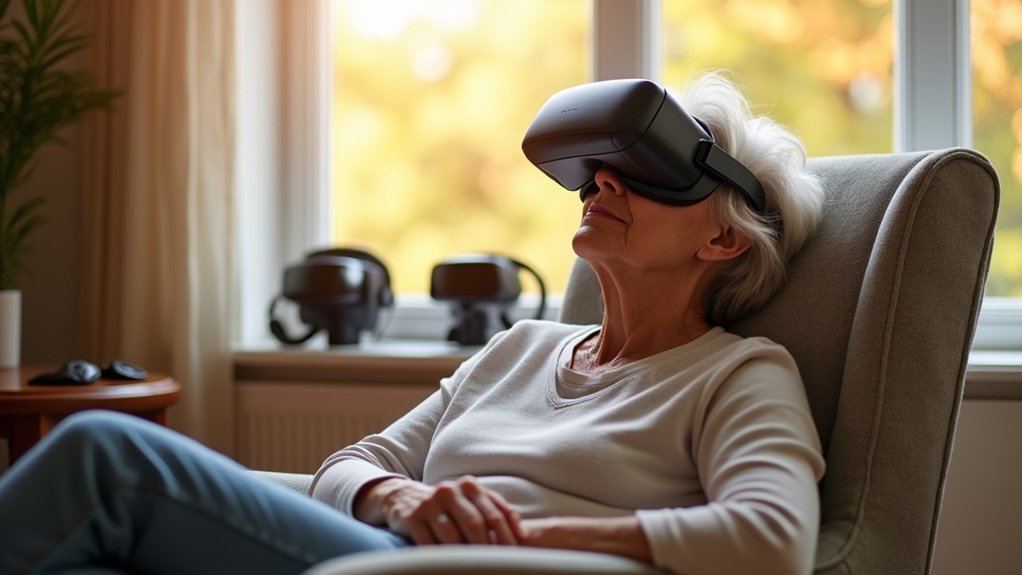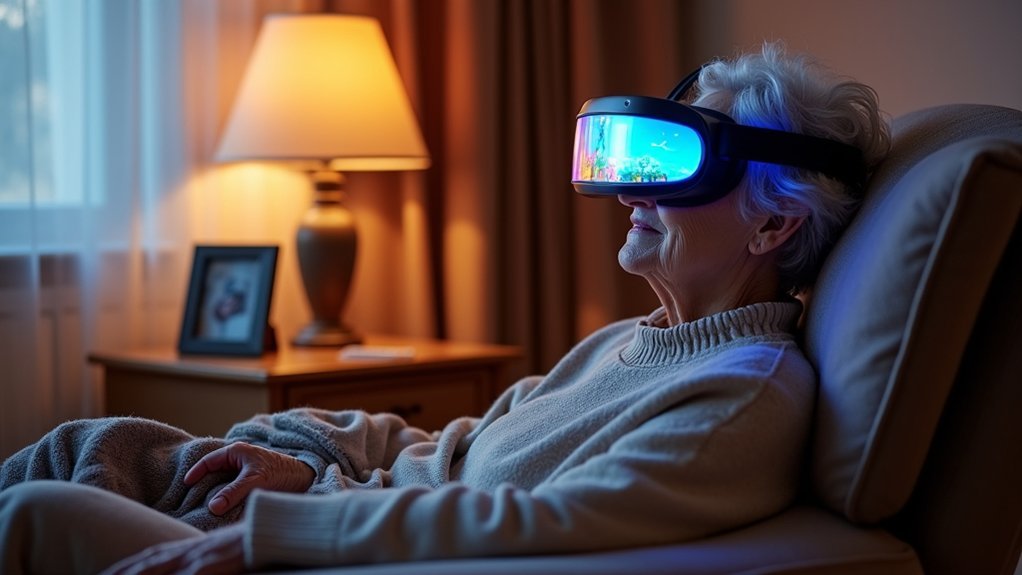You need specially designed comfortable VR headsets as a senior because standard models cause significant physical challenges. Heavy headsets create neck strain, while poor-fitting designs lead to pressure points and headaches. Without proper adjustability features like interpupillary distance settings, you’ll experience eye strain and motion sickness. Comfortable, lightweight headsets with ergonomic padding allow longer therapeutic sessions, reduce safety risks, and enable extended social engagement experiences that combat isolation and support cognitive health benefits.
Physical Challenges Seniors Face With Standard VR Headsets

Weight becomes a significant barrier when seniors attempt to use standard VR headsets.
You’ll likely experience neck strain and discomfort due to reduced muscle strength that naturally comes with aging. Standard VR headsets often lack proper adjustability features you need, including interpupillary distance settings and adequate padding for your facial structure.
These physical challenges extend beyond mere discomfort. You might find that poor-fitting headsets create pressure points around your temples and forehead, leading to headaches during use.
The rigid design of most standard models doesn’t accommodate the comfort requirements older adults need for extended sessions.
Without proper ergonomic design, you’re more susceptible to eye strain and fatigue.
Standard VR headsets simply weren’t designed with senior users’ physical limitations in mind, making comfortable experiences difficult to achieve.
How Comfortable Headsets Improve VR Session Duration and Enjoyment
When you wear a comfortable VR headset, you’ll notice you can enjoy virtual experiences for much longer without the nagging discomfort that cuts sessions short.
You won’t feel the typical pressure points, eye strain, or neck fatigue that force you to remove standard headsets after just 15-20 minutes.
This extended comfort translates directly into more immersive experiences and greater satisfaction with your VR activities.
Extended Wear Comfort
Since seniors typically have more sensitive skin and lower tolerance for pressure points, comfortable VR headsets become essential for meaningful virtual experiences.
Extended wear comfort directly impacts how often you’ll use VR technology, with studies showing that comfortable headsets lead to more frequent participation in virtual activities.
Well-padded headbands and facial interfaces prevent fatigue by eliminating pressure points that cause discomfort during longer sessions.
You’ll find that adjustable interpupillary distance and lightweight designs reduce eye strain considerably, allowing you to enjoy VR for extended periods without headaches or discomfort.
When your headset fits properly, you’re more likely to engage regularly with cognitive exercises, social experiences, and entertainment options.
This consistent usage pattern fosters improved mental stimulation and social connections that benefit your overall well-being through sustained virtual reality engagement.
Reduced Physical Strain
Properly designed VR headsets eliminate the neck and facial pressure that traditionally cut short your virtual reality sessions. When you’re not constantly adjusting an ill-fitting device or dealing with uncomfortable weight distribution, you can immerse yourself fully in therapeutic applications and social experiences.
Comfortable headsets feature ergonomic designs with soft padding and breathable materials that accommodate your unique head shape without causing irritation. This reduced physical strain directly translates to longer, more enjoyable VR sessions.
You’ll find yourself participating more willingly in cognitive exercises, virtual travel, and social interactions when comfort isn’t a barrier. The extended engagement time enhances the therapeutic benefits, leading to improved mental health outcomes and decreased isolation as you embrace technology without physical discomfort limiting your experience.
Weight Distribution and Ergonomic Design Features for Older Adults

As you age, your body becomes more sensitive to pressure points and weight imbalances, making the design of VR headsets essential for comfortable extended use.
Comfortable virtual reality headsets incorporate sophisticated weight distribution mechanisms that prevent strain on your neck and face during longer sessions. The ergonomic design features adjustable straps and cushioning that accommodate your unique head shape and size, ensuring a secure yet comfortable fit.
Modern VR headsets use advanced weight distribution and ergonomic design to eliminate neck and facial strain during extended gaming sessions.
Lightweight materials reduce overall headset weight, preventing fatigue that could limit your VR enjoyment.
Adjustable interpupillary distance settings let you achieve ideal visual clarity, reducing eye strain. Soft padding and breathable materials enhance comfort, especially if you have sensitive skin.
These thoughtful design elements work together to create an accessible VR experience that doesn’t compromise your physical well-being.
Vision and Hearing Accommodations in Senior-Friendly VR Devices
When vision and hearing changes naturally occur with age, VR headsets must offer specialized accommodations to guarantee you can fully enjoy virtual experiences. Senior-friendly VR devices prioritize adjustable interpupillary distance settings, allowing you to customize the distance between lenses for ideal visual clarity. These headsets accommodate prescription lens inserts and feature larger, sharper displays that work with your existing vision needs.
| Feature | Benefit | Impact |
|---|---|---|
| Adjustable IPD | Matches your eye spacing | Reduces eyestrain |
| Audio Enhancement | Amplifies sound clarity | Improves immersion |
| Hearing Aid Compatibility | Works with existing devices | Maintains comfort |
Vision and hearing accommodations in modern VR technology include built-in audio enhancements that compensate for hearing loss, ensuring you don’t miss vital audio cues during your virtual adventures.
Reducing Motion Sickness and Discomfort Through Proper Headset Fit

Since motion sickness affects up to 40% of VR users, achieving the right headset fit becomes your most effective defense against discomfort.
When your headset sits properly, you’ll experience noticeably less nausea and dizziness during VR sessions.
Look for adjustable interpupillary distance (IPD) settings that match your unique eye spacing. This feature reduces visual strain and creates a more comfortable viewing experience.
Choose lightweight designs with cushioned padding that won’t create pressure points on your face or head.
Adjustable straps guarantee your headset stays securely positioned without shifting during use. When your device moves around, it triggers motion sickness faster.
A well-fitted, comfortable headset allows you to enjoy VR activities longer without physical distractions interrupting your experience.
Safety Considerations for VR Use Among Elderly Populations
When you’re selecting a VR headset as a senior, you’ll want to prioritize safety features that prevent accidents and protect your wellbeing.
Look for lightweight models with secure but comfortable straps that won’t throw off your balance or create tripping hazards when you’re moving around.
You’ll also need to guarantee the headset offers proper vision comfort settings, including adjustable interpupillary distance and clear display options that won’t strain your eyes during extended use.
Fall Prevention Measures
Although seniors face unique safety challenges when using VR technology, comfortable virtual reality headsets equipped with proper fall prevention features can dramatically reduce these risks. You’ll benefit from lightweight designs that won’t compromise your balance while maintaining proper weight distribution. When you’re dealing with mobility issues, these fall prevention measures become even more critical for safe VR experiences.
| Fall Prevention Feature | Safety Benefit |
|---|---|
| Boundary Alert Systems | Prevents collisions with furniture |
| Lightweight Construction | Maintains balance and stability |
| Ergonomic Padding | Reduces disorientation risks |
| Adjustable Fit | Prevents headset shifting during use |
You’ll find that comfortable virtual reality headsets with built-in safety features help prevent accidents while ensuring you can enjoy longer, more engaging sessions without fatigue or discomfort.
Vision Comfort Guidelines
Beyond physical safety measures, vision comfort plays an essential role in making VR experiences enjoyable and safe for seniors. Age-related vision changes require specific considerations when selecting headsets.
Key vision comfort guidelines include:
- Choose headsets with adjustable interpupillary distance – This accommodation guarantees proper eye spacing alignment for ideal visual comfort.
- Select devices featuring high-quality lenses – Avoid fresnel lens systems that may cause discomfort for seniors with visual impairments.
- Prioritize lightweight and ergonomically designed headsets – Reduced weight minimizes neck and facial strain during extended use.
- Opt for high refresh rates and low latency – These features help prevent motion sickness and disorientation.
You’ll want to confirm the headset provides clear, crisp imagery while maintaining visual comfort throughout your VR sessions.
Enhanced Social Engagement Through Accessible VR Technology
Since comfortable VR headsets eliminate physical discomfort barriers, seniors can now participate in meaningful social experiences that were previously out of reach.
You’ll find that immersive technology creates virtual spaces where you can connect with family and friends regardless of distance or mobility limitations. VR for seniors addresses social isolation effectively, with 60% of users reporting decreased loneliness after regular use.
Applications like Alcove enable you to navigate shared virtual environments with loved ones, fostering deeper connections through storytelling and group activities.
VR platforms create meaningful shared spaces where families connect through interactive storytelling and collaborative experiences despite physical separation.
You’ll discover that 83% of residents and 95% of caregivers notice enhanced relationships through VR discussions. This engaging technology encourages fuller participation in social interactions, ultimately creating stronger community bonds within senior living environments.
Therapeutic Benefits Maximized by Comfortable VR Equipment
When you’re wearing a properly fitted VR headset, you can engage in longer therapeutic sessions that deliver maximum health benefits without the distraction of physical discomfort.
Comfortable VR headsets directly impact your ability to focus on healing activities, leading to measurably better outcomes.
The therapeutic benefits you’ll experience include:
- 8.8% improvement in information retention during cognitive training sessions
- Enhanced pain relief through extended guided meditation experiences
- Reduced fatigue during rehabilitation exercises, promoting natural movement
- 80% positive outlook improvement supporting emotional wellness
Without proper comfort, you’ll find yourself cutting sessions short or losing focus due to headset pressure and weight.
Lightweight, well-designed equipment guarantees you can fully immerse yourself in virtual travel, meditation, and therapeutic activities that require sustained engagement for ideal healing results.
Frequently Asked Questions
Are VR Headsets Good for Seniors?
You’ll find VR headsets beneficial if they’re comfortable and adjustable. They can reduce isolation, provide therapeutic experiences, and offer entertainment. Choose lightweight, standalone models with IPD adjustment for the best experience.
How Is VR Technology Curing Loneliness in Seniors?
VR technology’s curing your loneliness by connecting you with family through virtual environments, creating shared experiences with other seniors, and building community bonds that boost your emotional well-being and positive outlook.
What Is the Negative Effect of Virtual Reality Headsets?
You’ll experience discomfort from heavy headsets, motion sickness from rapid movements, eye strain from poor adjustments, navigation difficulties with limited dexterity, and increased isolation if you use VR without proper breaks.
What Is the Recommended Age to Use VR?
There’s no specific recommended age to start using VR, as you can benefit from it at any age. However, you’ll find it’s particularly valuable if you’re 65 or older.





Leave a Reply